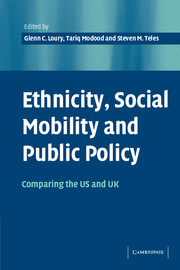Book contents
- Frontmatter
- Contents
- List of figures
- List of tables
- List of contributors
- Acknowledgements
- Introduction
- Part I Historical overviews
- Part II Informal social networks
- 4 Ethnicity as social capital: community-based institutions and embedded networks of social relations
- 5 Intergenerational mobility and racial inequality in education and earnings
- 6 Social integration and social mobility: spatial segregation and intermarriage of the Caribbean population in Britain
- 7 Ghettos and the transmission of ethnic capital
- 8 Family formulation in multicultural Britain: diversity and change
- Part III Formal structures
- Part IV Political institutions and processes
- Part V Normative analysis
- Author index
- Subject index
- References
7 - Ghettos and the transmission of ethnic capital
Published online by Cambridge University Press: 22 September 2009
- Frontmatter
- Contents
- List of figures
- List of tables
- List of contributors
- Acknowledgements
- Introduction
- Part I Historical overviews
- Part II Informal social networks
- 4 Ethnicity as social capital: community-based institutions and embedded networks of social relations
- 5 Intergenerational mobility and racial inequality in education and earnings
- 6 Social integration and social mobility: spatial segregation and intermarriage of the Caribbean population in Britain
- 7 Ghettos and the transmission of ethnic capital
- 8 Family formulation in multicultural Britain: diversity and change
- Part III Formal structures
- Part IV Political institutions and processes
- Part V Normative analysis
- Author index
- Subject index
- References
Summary
Introduction
African-Americans have experienced high levels of residential segregation from the racial majority for at least a century (Massey and Denton 1993, Cutler, Glaeser, and Vigdor 1999). Over the same time period, black socioeconomic outcomes have persistently lagged behind those of the majority, even as other initially disadvantaged ethnic and racial groups have experienced convergence (see Figures 7.1 and 7.2). Social scientists have developed and tested two causal explanations linking the former trend with the latter. First, the spatial mismatch hypothesis, proposed by John Kain in 1968, posits that residential segregation introduces a physical separation between blacks and centers of employment, which in turn adversely affects black outcomes. Empirical tests of this hypothesis (see Kain 1992, Ihlandfeldt and Sjoquist 1998 for recent reviews) have provided varying degrees of support for the hypothesis. Second, recent literature emphasizing the importance of neighborhood effects, peer groups, and social interactions proposes that segregation negatively affects blacks by separating them from positive role models, high-quality local public goods, or other important inputs into the human capital production function (Wilson 1987, Case and Katz 1993, Cutler and Glaeser 1997).
A natural question to ask upon examining this previous research is whether residential segregation per se has negative effects on socioeconomic outcomes, or whether the relationship between segregation and outcomes depends on specific factors, such as the proximity of ghettos to employment centers or the collective human capital of the segregated group.
- Type
- Chapter
- Information
- Ethnicity, Social Mobility, and Public PolicyComparing the USA and UK, pp. 204 - 221Publisher: Cambridge University PressPrint publication year: 2005
References
- 11
- Cited by



